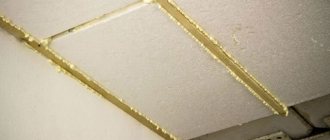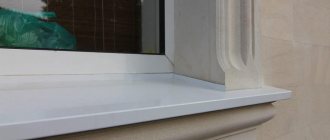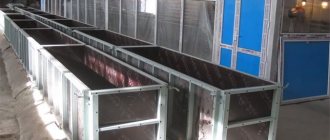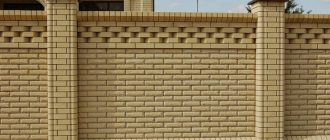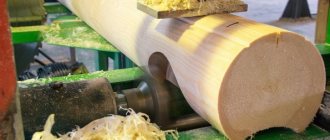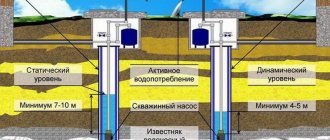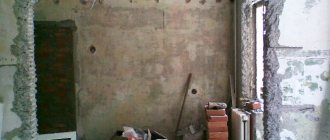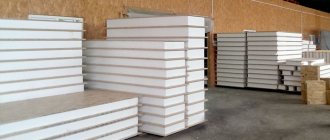Technical characteristics of polyurethane foam
Let's look at what polyurethane foam is. This material is considered one of the best for insulating aerated concrete and other surfaces. Foam of this type has both advantages and disadvantages, which can manifest themselves both during operation and in the future.
Typically, the main components of foam are special combinations of polymers. Initially they are in a liquid state, but after being applied to the surface when interacting with air, the foam hardens almost instantly, filling the pores and forming a very dense and reliable layer.
Positive properties
Let's consider the main advantages of using polyurethane foam for wall insulation. There are quite a lot of them, which explains such a high degree of demand for the material among builders and people who started insulating walls.
Window insulation with polyurethane foam
- Very high degree of sound insulation. As a rule, foam today is even better than extruded polystyrene foam at isolating a room from extraneous sounds. This applies to both external and internal insulation. In both cases the effect will be achieved. Only natural cork material can compete with foam in terms of sound insulation.
- Absolute degree of environmental friendliness. This property allows you to use polyurethane foam for any purpose, even for sealing cracks in the walls in a children's room. The foam does not emit any toxic substances even when exposed to external factors.
- Polyurethane foam is relatively resistant to negative environmental factors; it is a non-flammable insulation material. She is practically not afraid of rain, wind, or extreme heat. The polymer composition gives the polyurethane foam greater stability, especially high if a protective layer of plaster is applied on top of it.
- Polyurethane foam is quite easy to work with. It has good adhesion - it adheres perfectly to almost any surface, it can even be applied to metal panels. Has the ability to expand several times. As a result, even a large crack can be filled with a small amount of liquid foam.
- The degree of thermal conductivity of foam is considered one of the minimum among other materials for insulating walls in a house. This allows it to retain heat in the room and keep air and moisture out. And fire resistance protects the house from fire.
Disadvantages of polyurethane foam
But there are also disadvantages to using polyurethane foam. Of course, there are not as many of them as advantages, but still they must be taken into account. This will allow you to avoid mistakes and make the right choice.
Sealing cracks with foam
- Polyurethane foam is not resistant to ultraviolet radiation. As a rule, after sealing cracks and cracks, additional materials should be applied on top or finished with slabs. This will protect the foam from exposure to sunlight, which causes the destruction of polymers in the structure.
- Another disadvantage is the cost. Now on the building materials market you can find many types of foam, which differ from each other in their characteristics. But usually even a small bottle of foam is not cheap. And when working with damaged walls and large areas, you will have to buy a lot of foam at once.
So, if you carefully weigh all the pros and cons, you can choose a good polyurethane foam that will serve for a long time and will firmly protect the inside of the house. Taking into account all the subtleties described above will not allow you to make a mistake.
Criterias of choice
When choosing a product for insulating the walls of a house, the performance characteristics of the product are taken into account:
- indicators of thermal insulation properties;
- level of environmental friendliness of the product;
- flammability class;
- weight characteristics.
Things to consider when choosing insulating foam:
- penoizol does not have significant adhesive properties, therefore it is not used for insulating open areas. Liquid foam under pressure is used to fill cavities in a wall structure or the material is used for thermal insulation of horizontal sections. For example, if you plan to insulate the attic, the floor area is treated with foam insulation for high-quality heat and sound insulation;
- choose polyurethane foam if local work is required in the form of sealing joints or cavities between structural elements, insulation or cladding;
- Polyurethane foam as a universal product is used when performing thermal insulation work of any complexity.
When choosing foam for wall insulation, you need to take into account the flammability class.
The choice of material is also influenced by the cost of the product and the conditions of use.
Polyurethane foam and penoizol belong to the solutions of the affordable segment. In this case, the first option is intended for semi-professional and professional use. Polyurethane foam is produced in small cylinders that are equipped with a tube for spraying a gaseous mass or a gun; the cost of the product varies depending on the model and brand. Penoizol is manufactured directly at the site of application using special equipment. As for spray polyurethane foam, the curing compound is also done using a professional installation.
Some important tips
Before you choose this material and start insulating walls with foam, you should take into account useful tips for choosing and working with insulation
Let's consider in what cases and how best to insulate walls.
For dealing with cracks on the exterior walls of a home, the polyurethane foam type is ideal. It can also be used to insulate the floor if it is an open veranda, and also for insulating the attic. But if you decide to make a room out of the attic where you plan to spend a lot of time, or the windows face the sunny side, then it is not recommended to use polyurethane foam there either.
If you plan to fill a large space with foam or fill it, then the use of penoizol will be indispensable. But don’t forget about purchasing a special spraying apparatus, because... a regular bottle won't be enough.
If you need to repair cracks and other defects in the wall or provide thermal insulation in small areas, then it is better to insulate the house with polyurethane foam in cylinders. This non-flammable insulation is environmentally friendly and becomes quite dense after final hardening.
There is one more tip about applying foam. If it is necessary to repair external defects, then the technology of applying foam is direct - using a balloon or a special apparatus. But if defects are found in the thickness, then it is necessary to use a long hose to push the foam. Just before doing this, you should drill a couple of holes in the wall.
Advantages and disadvantages
The undeniable advantages of the substance in question, which the manufacturer usually indicates on the packaging, include:
- High degree of adhesion - that is, its ability to firmly attach to many surfaces. The exceptions are Teflon, silicone, ice, polyethylene and oily surfaces;
- Heat resistance (usually ranges from -45 °C to +90 °C);
- Cured polyurethane foam is a dielectric (does not conduct electric current);
- Quite fast hardening speed - from eight minutes to a day;
- High moisture resistance;
- Lack of toxicity (of course, after final hardening);
- A small percentage of shrinkage (no more than 5%) throughout the entire period of operation;
- Chemical resistance;
- High strength;
- Long service life of the material (up to half a century).
Disadvantage: cost of material and equipment.
Also no less important characteristics are:
- The total volume of sealant output is calculated in liters and refers to the amount of foam coming out of a unit of container. This characteristic is affected by ambient temperature, humidity and windiness.
- Viscosity mostly depends on air temperature. Temperatures above (or below) certain limits specified for each type of foam will negatively affect the viscosity of the substance. This is bad for masonry.
- Primary and secondary expansion. Primary expansion is the ability of the composition to expand immediately after leaving the cylinder in a very short time interval (up to sixty seconds). In this short period of time, polyurethane foam sealant is able to increase in volume by 20-40 times. Secondary expansion refers to the ability of a synthetic polymer to expand for a long time before polymerization finally stops.
High-quality polyurethane foam has a pleasant light yellow or slightly greenish color; it does not flow down when applied to the surface and is even suitable for the roof. It is not eaten by rodents and insects, and does not harm the environment.
When hardened, the substance turns into a durable, porous, seamless material that is quite moisture-resistant and has excellent insulating properties.
Polyurethane foam sealant is chemically inert, which is both its advantage and disadvantage.
After it hardens, it is not susceptible to the destructive effects of solvents, so its excess will have to be removed mechanically - using a scraper or pumice.
It is important to note that under the influence of solar ultraviolet radiation, this insulating material is subject to rapid destruction - first it darkens and then becomes brittle.
Never forget to plaster the foam-filled area after it has hardened. Otherwise, it may simply turn into dust.
Polyurethane foam is suitable for insulating a frame house. It will serve as a special air gap.
Types of foam insulation
Foam insulation may differ in its structure and composition. We can distinguish the main types of material for insulating walls and windows:
- Penoizol. It contains aldehydes, which are harmful to health, although manufacturers often claim the opposite. It dries much longer than polyurethane (complete drying time can reach three days). Typically used for insulating attics, load-bearing walls and structures. Can be purchased in the form of ready-made slabs or as a liquid composition.
- Ecowool and foam concrete. Can be purchased in liquid form, most often used for pouring foundations. They are practically not used when finishing facades due to their significant weight, which puts a large load on the walls. In addition, the high cost often speaks against this material.
- Polyurethane foam. Suitable only for sealing seams, joints, holes, since it does not allow moisture and steam to pass through, and this is a critical point for insulating material. When interacting with air, its volume increases twenty times, while there is a minimal amount of air bubbles inside. Can be purchased in convenient small-volume containers that have a significant shelf life.
- PPU or polyurethane. The most common option, which is considered the most universal. Polyurethane insulation is very effective as thermal insulation for facades. It consists of two components; they must be mixed by machine immediately before application. The foam expands thirty to forty times from its initial volume, and small balloons form inside. Due to this, high-quality insulation of the house is achieved.
Features of insulation
To independently insulate a house with foam, you need a protective suit. Foam is usually sprayed from a can onto the entire surface of the facade; it fills the voids between walls, rafters, and beams.
There are many advantages to this type of wall insulation with foam in the air gap. The main ones include:
- vapor permeability;
- fire resistance;
- ability to increase in volume;
- resistance to various types of mechanical stress;
- the upper temperature limit remains within +80 degrees.
Foam is often used to seal cracks that remain after installing plastic windows. Due to this, the thermal insulation in the apartment also increases. It is convenient to use a pneumatic gun for insulating not only windows and external walls, but also foundations, loggias and balconies, and pipes.
After treatment with foam insulation for walls, the facade turns out perfect - without visible joints or seams. One cylinder contains on average 600-700 ml of the composition, which is enough to treat a square meter with a layer up to eight centimeters thick. Operating such a gun is very simple: first, a full cylinder is inserted into it, then you need to point it at the surface to be treated and pull the trigger. On average, the applied composition hardens within 24 hours.
Advantages and disadvantages of polyurethane foam
Polyurethane foam (PPU) is a type of foam, that is, gas-filled plastic with a cellular structure. Getting on the insulated surface, the foam creates a uniform, homogeneous layer, which is an effective heat insulator. Insulation of a house with foam can be done both on the outside of the walls and on the inside; it can also be used for thermal insulation of the roof and foundation. The scope of application of polyurethane foam depends on its density. Thus, polyurethane foam with 90% closed pores is used to insulate country houses with a forced ventilation system, as it is vapor-tight. To ensure “breathable” walls, polyurethane foam containing 50% closed and 50% open pores is required.
Conclusion
Foam insulation can be used for walls made of various materials, including aerated concrete, blocks and reinforced concrete panels. Therefore, they are used for insulation of private cottages and apartments. Before giving preference to any one type of foam, consult a specialist.
If you have decided to insulate your house with liquid foam, this is the right intention. Always try to buy raw materials from the best domestic and foreign manufacturers. This way you will be able to avoid premature wear of structures.
Other types of wall insulation
One of the materials used in repairs and construction is penoizol. It is often sold not in liquid form, but as ready-made hardened panel sheets, similar to basalt insulation for walls. This is a fairly reliable material for insulating aerated concrete; it is characterized by a fast hardening time (about 3 days) if used in the form of a liquid solution. Finished sheets do not require hardening.
But it should also be understood that penoizol has a certain degree of danger to human health, just like extruded polystyrene foam. If it is used in sheets, then there are harmful formaldehydes that are released at high temperatures. It is not recommended to use this foam material inside living rooms.
Insulation of walls with ecowool
Polyurethane foam is another non-flammable insulation material. This material is two-component, but it is not harmful to humans. The main thing is to follow the correct installation technology on the wall surface. As a rule, polyurethane foam insulates the room very well, including from air.
For this reason, care should be taken in advance to ensure sufficient air flow into the rooms from the ventilation. Otherwise, the room will not have a normal microclimate. It is polyurethane foam that can expand 2-3 times more than regular polyurethane foam. This makes the consumption of material for sealing cracks much less. But be sure to use plaster over polyurethane foam.
Ecowool or foam concrete is also often used. It is difficult to say which insulation is better. These materials are not bad in quality, but in terms of fire safety they are very flammable. This is especially true for ecowool. Working with such insulation is not so easy; in addition, they are heavy.
More about types of coatings
In private housing construction, two main types of foam are used when it comes to insulation. These are materials based on penoizol and polyurethane foam. Let's take a closer look at them.
Penoizol
Part of the group of foamed plastics. After hardening, a fine-cell structure is formed. It can be supplied in the form of liquid raw materials for spraying, as finished slabs of standard sizes, as granules with which voids are filled. For frame structures, penoizol is an excellent option.
Advice! On sale you can find a special foam generator, thanks to which you can apply foam insulation by spraying.
Advantages of penoizol:
- Resistance to moisture and temperature changes;
- Easy to apply;
- Long service life;
- It doesn't burn much;
- It is elastic and resistant to deformation.
In addition, insulating foam is not afraid of mold and is not spoiled by pests.
PPU
After contact with air, a monolithic structure is obtained, in which the cell closes. Thanks to this, the strength of polyurethane foam increases when compared with polyurethane foam. The optimal layer for high-quality insulation is from 5 to 15 cm. The advantage is high adhesion rates to the following surfaces:
- Wood;
- Stone and brick;
- Metal;
- Plastic.
Since the microcells of polyurethane foam are closed, it will not absorb moisture and act as a waterproof layer. It can be used for walls indoors or outdoors.
If you insulate your house with foam, you can get the following benefits:
- Light weight.
- Excellent ability to fill all cracks due to its high fluidity in the liquid state.
- Low vapor permeability.
- Resistance to biological influence.
The disadvantages of the heat insulator are still the same: the need for special equipment for installation and increased cost.
Polyurethane foam
This is one of the budget options, which is most often used for spot insulation. For example, foam is good as a filler for cracks and spaces created in window and door frames.
However, it is irrational to use foam, since the consumption will be huge, but there will be little use. Polyurethane foam is often used to fix sheet solid insulation, as well as to eliminate cold bridges (joints between slabs).
Cylinder assembly
It is best to carry out insulation with this type of insulation in small areas, because its use in large areas is not always economically feasible.
The reason here is that polyurethane foam is sold mainly in small volume containers, approximately 200 and a maximum of 750 ml.
The largest of them are inexpensive, but they are enough to process only 1 square meter. m of any surface, but taking into account that the layer will be applied no thicker than 8 cm.
After insulation with this material, the thermal insulation of the surface will be several times lower in comparison with the use of the other two types of foam. The reason is that in such insulation half of the cells remain open, whereas in the same polyurethane foam the number of closed pores reaches 90%.
The process of foaming polyurethane foam occurs due to the fact that it is supplied to the surface under high pressure.
In addition, this process intensifies after the material reacts with moisture in the air.
The use of this insulation is common for sealing both window frames and during the installation of doors. It is also advisable to insulate the walls of a small area, for example, a loggia or closed balcony.
This insulation has a more complex composition than classic polyurethane foam.
It is produced in the form of slabs, which is somewhat similar to classic polystyrene foam.
Being in this form, it is more protected from external factors for storage and transportation.
But to bring it into a liquid state at the point of use, a special device is used. It not only melts penoizol, but also mixes it with resin. When insulating walls using such insulation with your own hands, you use a special construction gun.
Foaming begins inside this device and then it is applied to the surface, where it hardens after 15 minutes. For the material to completely harden, you need to wait several days.
Due to the fact that it has a long period of complete hardening, brick-type walls are most often insulated with foam insulation. The material is also often used for thermal insulation of formwork, as well as for insulation of frame houses.
Which variety to choose
In many ways, the choice will depend on the specific situation and what area needs to be treated. Using an example, we can consider the most common cases when a house needs foam insulation:
- If you need to seal cracks or eliminate any other defects on the surface, then polyurethane is suitable. But such material should not be exposed to sunlight.
- If you need to fill a large volume, then penoizol is suitable. But an ordinary cylinder will not be enough; you will need to purchase a special device with high pressure. You don’t have to buy it at all - you can rent it or borrow it from friends, because no one will use it often.
- If you need to seal small cracks and carry out thermal insulation in small areas, you can buy a cylinder with regular polyurethane foam. It does not support combustion, after hardening it is particularly hard, and it has an ecological composition.
- If defects are found on the outside of the wall, then you need to apply a composition based on polyurethane. It is applied directly using a special cylinder or apparatus.
It is worth remembering that foam insulation creates errors inside the layer that need to be eliminated. To do this, you will need a long hose to push the material inside. If it is necessary to fill air gaps inside the insulation, then holes are made in the wall with something sharp.
Polyurethane foam is not suitable for insulating the entire external facade - it does not have the appropriate characteristics necessary for this. Therefore, you should not choose it for these purposes, even despite its more economical cost.
Is it possible to insulate walls with foam?
It is widely used for insulating walls outside and inside.
Apply using a special apparatus or a pistol. The material fits well on vertical, horizontal and inclined surfaces. Features of wall insulation:
- The walls become thicker, which leads to greater resistance from environmental influences.
- The material can withstand temperatures up to +80.
- Vapor permeability.
- Resistant to various damages. It will not crumble from impact or become deformed.
- The material does not burn.
The following objects are insulated:
- window openings;
- walls from the street;
- foundation;
- balcony, attic;
- pipelines;
- attic spaces.
After application there are no seams or joints. The foam hardens in 1 to 3 days, depending on the number of layers applied.
Inside
Warming indoors is carried out as a last resort.
Only when it is not possible to carry out work, if the apartment is on the upper floors. This is indicated in SNiP 23-101-2004. When insulating walls indoors, you should take care of waterproofing, because the dew point shifts. The walls will be wet, which will lead to the appearance of fungus and destruction of the supporting structure.
Outside
Insulating the outside is the right solution. The main factor is not the violation of the dew point. The walls will be warm and dry.
Benefits of insulating from the outside:
- High energy saving data.
- Inside, the footage remains the same.
- No condensation.
- Sound insulation performance improves.
Disadvantage: foam insulation requires the use of equipment.
Even with the inflated cost of the materials, the equipment used, and the work of the craftsmen, this pays off in savings (payment for heat), silence, and comfort.
Is it possible to insulate with foam yourself?
Basically, they carry out internal thermal insulation work on their own. For this you need:
- Wooden slats or metal profiles as guides for sheathing.
- Foam cans and a construction gun.
- Construction knife.
First, the surface in the house is cleaned of dust, flowers, and cobwebs. After this, the profiles are fixed in increments of 50 cm vertically along the wall, with horizontal jumpers of 50 cm.
In order not to smear the furniture and pipes, it is necessary to cover everything with film.
Further:
- Safety precautions: glasses, protective clothing, gloves.
- Apply a little automotive lubricant to the construction gun for better performance.
- Insert the can into the gun.
- Apply foam to the surface.
Clean the gun after use. If there is any liquid left in the container, close it tightly.
Wait for complete drying - from 1 to 3 days. Then carry out the final finishing.
Installation of wooden or metal beams
Before installing the sheathing, it is necessary to prepare the surface.
Cleans from dust and cobwebs.
If installation work is carried out outdoors, then remove old whitewash, swollen plaster, pieces of cement, and other protruding objects.
After cleaning, fix the guides (wooden slats or metal profiles) in increments of 50 cm. For strength, horizontal jumpers are made every 50 cm. Hardware is used depending on the surface material (anchor, dowel-nails).
A layer of deep penetration primer should be applied to a clean surface. This will act as an additional protective layer.
All work on laying electrical cables and other communications is done before insulation begins. Electrical wires are laid in corrugation.
Spray foam application by compressor
First, you need to fill all the cracks, joints, and cracks with material. This will get rid of voids where a cold bridge may occur. As well as voids that arise at the junction of the sheathing and the surface.
After this, spraying is done with even sweeping movements from side to side. The surface is covered from top to bottom.
If you need to coat a metal surface, you must first clean it of rust and then treat it with an anti-corrosion agent.
While performing the work, make sure that the sheathing remains visible. The finishing coating (plasterboard, chipboard, other materials) will subsequently be fixed onto it.
Drying
Foaming of the material takes place inside the equipment.
After application, hardening will occur within 15-20 minutes. Complete drying occurs in a day or three. Experts recommend starting finishing after 5 days.
Alignment
After 5 days, you need to level the surface before finishing coat. To do this, use a construction knife to cut off excess frozen foam. They do this level with the sheathing. The surface should be smooth, without depressions or bumps. If it is difficult to work with a knife, take a hacksaw with fine teeth.
Afterwards the finishing is fixed onto the prepared surface.
Finishing
The surface of their foam is not covered with various types of plaster, putty, or wallpaper. For cladding use:
- drywall (regular, moisture resistant);
- plastic, glass wood panels;
- lining;
- Chipboard, fibreboard, OSB.
The material is fixed with hardware to the previously created sheathing. A waterproofing layer is not required.
Foam cost
If you buy a cylinder at retail, then on average you can pay 300-500 rubles per piece. But this type of insulation is rarely purchased separately. Usually its cost is included in the cost of work:
- polyurethane foam - about 100 rubles per linear meter;
- penoizol - 700−2000 rubles per cubic meter;
- polyurethane - 3000−5000 per cubic meter.
The price of the material also plays a big role in its selection.
But you shouldn’t skimp on high-quality thermal insulation if you need to insulate your home for a long time for a comfortable stay. Foam insulation is suitable for most walls, including panel, block and aerated concrete. Therefore, they can be safely used as insulation for apartments and private houses. What type of foam to choose is a purely personal matter for everyone. But first, it still doesn’t hurt to find out more about the selected composition, read reviews, and get advice from a salesperson at a hardware store. It is not recommended to use loose-fill insulation, which easily catches fire, unlike the foam fireproof version. And it is not the most convenient to use, the only exception being the floor surface.
Insulation with liquid foam is a better solution, because if desired, this procedure can be carried out independently, without the help of specialists
If you do everything correctly and be careful, you will be able to quickly insulate any surface that needs it.
Technology of facade insulation with polyurethane foam
The technology of applying liquid insulation requires special knowledge, skills and equipment, so doing it yourself is difficult. To carry out the work, it is best to hire a team of experienced craftsmen who will quickly perform the necessary actions and be able to provide guarantees of the quality of thermal insulation.
High-quality insulation of the facade of a house with polyurethane is possible only for low-rise buildings. The purpose, size, configuration and geometry of buildings is not important. The whole procedure goes through several stages:
- wall preparation;
- application;
- reinforcement;
- finishing activities and finishing work.
Selection of equipment for spraying polyurethane foam
The equipment consists of:
- Two cylinders intended for foam-forming compounds
- Hoses connecting cylinders to spray guns.
Figure 3. Equipment for spraying polyurethane foam. - Spray gun.
- A set of nozzles of various modifications.
- A set of keys and technical lubricant.
The set of equipment for spraying is quite voluminous and expensive, so it is not practical to buy it for insulating your own walls yourself. It would be much cheaper and more reasonable to hire a team of equipped craftsmen.
Instructions for spraying polyurethane foam on the facade
The equipment can be household (disposable) or professional. Assembly of the entire structure is quite simple - hoses with a gun are connected to the cylinders - and you can start spraying.
The optimal temperature of the components for application is 20-30 degrees Celsius. The area of thermal insulation material for insulating facades by spraying depends on the volume of the cylinders. If you need to pause while performing liquid thermal insulation, you should take into account that the operational life of the equipment does not exceed 30 days, so you should not delay too long. That is why experts do not recommend purchasing cylinders with a volume of open polyurethane foam larger than necessary.
Preparation for applying polyurethane foam
The characteristics and properties of polyurethane foam for work require protective clothing. It is important not to leave any exposed skin or hair because once it gets on the skin, the foam is extremely difficult to remove. To prevent small particles of foam from getting into the lungs, all work is carried out in a respirator or mask.
The walls must be cleaned of self-releasing particles and old coatings. Lighting fixtures, ebbs, grilles and other elements are removed. A sheathing with cells of 20-50 cm is installed. Installation is carried out using a level, which helps to level the walls. Next, a layer of polyurethane .
Rules for façade reinforcement
To avoid the formation of cracks in the openings, and to ensure that the finishing materials fit well, it is recommended to reinforce the walls with a special mesh. The procedure begins with the installation of aluminum perforated corners to which the mesh will be fixed. The corners are installed with mounting adhesive and carefully pressed down with a spatula. Excess glue is removed.
The reinforcing mesh is made of fiberglass and is resistant to chemical and mechanical influences. It is fixed with an adhesive solution, which is sold ready-made in hardware stores.
Figure 4. Insulation of facades by spraying.
To achieve good quality, polyurethane foam is processed with coarse sandpaper. After removing the dust, glue is applied to the surface, into which the mesh is carefully embedded. The glue is evenly distributed over the surface. The mesh does not need to be tightly stretched or pressed into the heat-insulating layer. When the entire façade has been reinforced, it is recommended to apply a second layer of adhesive with a mesh that should not show through.
Carrying out finishing work
It takes a day for the reinforcing layer to dry and after that you can begin finishing work. In order not to violate the integrity of the thermal insulation layer, it is not recommended to use siding or other materials that are mounted on dowels or screws.
The best option is simple decorative plaster for finishing facades. This will allow you to create any effect you like and paint the house in your favorite color.
If you are looking for the most effective method of organizing ideal thermal insulation for your home, polyurethane foam is perfect. Since the procedure requires compliance with certain rules, you should carefully, realistically and adequately assess your strengths, and it is best to invite a team of experienced craftsmen.
Advantages and disadvantages of foam insulation
Thermal insulation with foam has its advantages:
- Fast processing of even large areas.
- Does not require the installation of lathing, additional profiles, hydro- and vapor barrier films and membranes.
- Does not rot, does not contribute to the growth of mold and fungi.
- It is classified as highly flammable, does not burn, but melts.
- When interacting with metal, it creates a dense anti-corrosion coating.
- Seamless uniform surface with good heat-saving characteristics.
Foam is not a new method of insulation. But, unfortunately, it is not as studied as mineral wool or polystyrene foam - it is difficult to talk about such indicators as environmental friendliness and durability. However, there are several disadvantages inherent in this particular type of insulation:
- Afraid of direct sunlight.
- Does not withstand constant contact with water.
- The original product is not cheap and requires special application conditions.
- A special suit made of tarpaulin, gloves and a respiratory mask with goggles are required.
- Due to the low level of vapor permeability, a thermos effect is created inside the room, so a forced ventilation device is needed.
In search of reliable and safe insulation, builders sometimes use the most unconventional materials and methods. The effectiveness of foam spraying has been proven and does not require large investments or labor costs.
The main thing is to be careful when working and not to leave treated surfaces without a final protective coating.
Popular manufacturing companies
Today in Russia there are a large number of manufacturers of penoizol, polyurethane foam, polyurethane foam and other liquid mixtures that are used for insulating premises. Among the domestic manufacturers, the most famous are the following:
- "Dau-Izolan";
- NVP "Vladipur";
- "ChemSupplier Don";
- "Elastokam";
- CJSC "Uretan";
- "Khimprom".
If we are talking about buying a disposable construction tool, then it does not matter what brand it is produced under. Along with Russian ones, Chinese kits are also very popular. At the same time, the choice of the material itself must be taken seriously. To avoid premature wear of structures, it is advisable to purchase raw materials of domestic or European production.
Why do you need to insulate your house? Most likely, this question will cause confusion among many ordinary people.
A residential building must be insulated. If you reliably insulate a residential building, you will be able to create a stable internal microclimate at any time of the year. Thus, how comfortable the homeowner and all members of his family will live will not depend on temperature changes and the vagaries of nature. By also insulating the house, you will ensure reliability of all elements of the structure and increase their durability.
Before starting to build a private house, it is worthwhile to think through the issue regarding the insulation of not only the walls and ceiling, but also the entire structure. These activities can be carried out not only at the construction stage, but also during the operation of the building (this is best done in the warm season).
If a residential building has unsatisfactory thermal insulation performance, this will negatively affect not only the people living in the house, but also the building itself.
All members of your family will be susceptible to frequent colds. Life in cold rooms will not be comfortable. The walls of the house will be subject to freezing, and then the appearance of mold and mildew on them.
If all structural components of a building have increased thermal conductivity, this will cause self-destruction of building materials.
From the above, one conclusion suggests itself: a residential building needs to be insulated . And how this can be done must be decided by each homeowner individually.
You can insulate your house with one of these materials:
- mineral wool;
- Styrofoam;
- extruded polystyrene foam;
- penoplex;
- penofol;
- penoizol;
- polyurethane foam.
How to insulate walls
With proper preparation, doing the insulation yourself will not be difficult. One person is enough to interact with simple budget equipment formats. If a high-performance complex with extended hoses is used, it is recommended to invite an assistant.
Preparation
In order for the insulation to be firmly fixed on the walls, preparation is needed. The first thing to do is to completely dismantle the old finish, clean and dry the surface.
Beacons, the role of which will be performed by vertically located guides, will help to obtain an even application. They need to be attached in increments of 0.5 m; you can use metal profiles or wooden blocks. This is necessary so that you can then cover the walls with plasterboard or other material.
If cladding is not planned, guides are not used.
The installation of communication lines and electrical wiring must be completed before spraying the insulation. It is better to use corrugated plastic or a metal sleeve for laying wires.
Pouring foam
The process of foaming walls begins with filling the voids that occur between building components during the overall construction process.
When insulating cavities between walls, you need to drill several holes inside them.
When lathing the base, the foam is first driven into the areas where the material adjoins the base. Then, it is distributed with wide, even movements, and the vertical sections are worked from the bottom up.
When you need to bypass the pipeline, you need to clean it, degrease it, coat it with an anti-corrosion agent, and then cover it with insulation.
When the foam has completely dried, you can level it a little, plaster and paint it.
